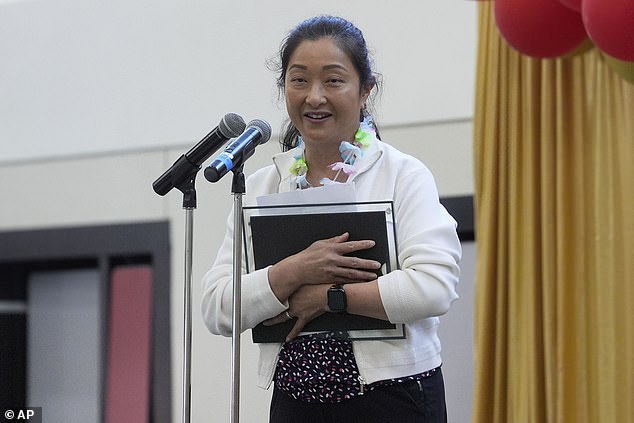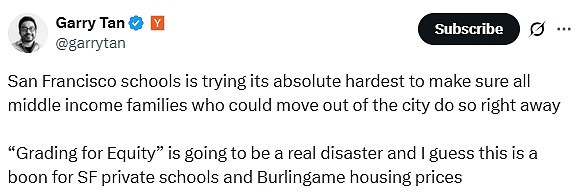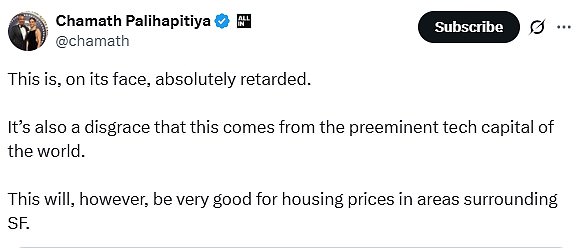Today, San Francisco’s top educator faced an embarrassing reversal of their stance regarding education policies.
woke
New initiative aims to reduce passing thresholds as part of efforts to foster ‘fairness.’
School Superintendent Maria Su introduced the new ‘Grading for Equity’ initiative last evening. The proposal suggests eliminating homework and weekly assessments, allowing students to pass with a minimum score of 41 instead of the present requirement of at least 61.
However, mere hours later on Wednesday afternoon, Su issued a statement after facing extensive criticism from various political factions, indicating that the district would postpone enforcing the measure for one year.
She stated: “During the Board of Education meeting on May 27, we introduced a proposal for a professional development initiative focused on standards-based grading. However, no decisions were made during this gathering. The district and the Board of Education have not implemented any modifications to their current grading methods.”
We set high expectations for all SFUSD students and aim to foster their success by focusing on learning and proficiency. Clearly, many questions, concerns, and misconceptions have arisen regarding this proposal.
We aim to guarantee that all modifications positively impact our students. Therefore, I’ve opted against pursuing this approach for the upcoming year to allow sufficient time for meaningful involvement of the community.
At present, our priority should be to maintain fiscal discipline, stabilize the district, and restore confidence.
Ro Khanna, a Democratic representative from Silicon Valley who advocates for progressive principles, criticized the action on X, stating: “My immigrant father questioned me about the omitted 10% when I achieved a score of 90. He moved to America seeking the opportunity to work diligently and strive for excellence.”


‘Achieving an A grade with only 80% effort and eliminating homework does not promote fairness—it undermines the American Dream and disregards every parent’s aspiration for their children to excel.’
According to
The Sound of San Francisco
, the plan was scheduled to be implemented later this autumn.
The report indicated that the updated plan would basically remove homework and weekly tests from contributing to a student’s final semester score.
A student’s grade will depend entirely on their final exam, which they have the option to retake several times.
Students may submit assignments tardily or skip classes altogether without this impacting their final grade.
Existing cutoffs require students to achieve a score of 90 for an A grade and maintain a minimum of 61 for a D grade.
The modifications imply that a score as low as 80 will now be considered an A grade, whereas a mark of 21 will equate to a D grade.
Democratic venture capitalist Garry Tan sharply criticized the decision. He stated, “The San Francisco school system is doing everything possible to ensure that all middle-income families who have the option to leave the city will do so as quickly as they can.”



‘Grading for Equity’ is likely to create significant problems, and perhaps this will benefit San Francisco’s private schools and drive up property values in Burlingame.
‘To the education officials who undermine our public schools with unjust and non-merit-based policies: BUSINESSES ARE THRIVING.’
‘An investigation into the Schools of Education responsible for generating these policies is necessary since they pose a significant threat to public schools across the board.’
Entrepreneur Chamath Palihapitiya commented: “On the surface, this is completely absurd. It’s also shameful that such an issue arises from what should be the leading technology hub globally.”
This will significantly benefit housing prices in regions around San Francisco.
As reported by the source, the district sought advice from Joe Feldman, who had assisted in introducing a comparable system in Placer County back in 2019.
In a 2019 piece published by the School Superintendents Association, Feldman stated: “The number of students getting D’s and F’s dropped—especially among students of color and those with special needs.”
As indicated by the decrease in the number of students earning A grades, grade inflation declined, with a sharper drop observed particularly within the more advantaged student groups.
The accuracy of students’ grades increased rather than merely improving. Better grading methods notably narrowed the gap between students’ grades and their performance on standardized tests covering the same material. This improvement was particularly pronounced and frequent among students eligible for free or reduced-price lunches.
‘Both students and educators noted more relaxed classroom environments and improved connections between teachers and pupils.’
The Voice indicated that the new system would follow a model used in the San Leandro Unified School District.
In that school district, students can receive an A for scoring 80 percent and pass with a D at 21 percent.
Read more







